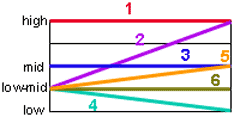Complete Guide to Cantonese Tones 聲調
Master the 6 Essential Tones of Cantonese - Your Comprehensive Learning Resource
Quick Navigation
Introduction to Cantonese Tones
Cantonese tones are fundamental to speaking the language correctly. There are 6 distinct tones in Cantonese that you must master to be understood. You need to rise, maintain, or lower the relative pitch of your voice to "sing" each word correctly. For example, in English we naturally use a falling tone at the end of a statement (You came.) and a rising tone at the end of a question (You came?).
To be understood in Cantonese, it is essential that you master all six tones. Using the wrong tone can completely change the meaning of what you're trying to say, leading to misunderstandings or confusion.
Tone Chart

Tone Details
| Number | Tone | Pitch | Contour | Example | |
|---|---|---|---|---|---|
| 1 | High | Level | 中 |
Chinese | |
| 2 | Low-Mid to High | Rising | 講 |
speak | |
| 3 | Mid | Level | 澳 |
bay | |
| 4 | Low-Mid to Low | Falling | 沉 |
sink | |
| 5 | Low to Low-Mid | Rising | 買 |
buy | |
| 6 | Low-Mid | Level | 賣 |
sell | |
Audio Examples
Tones can be rising, falling or level. In level tones, your voice stays flat at a certain level and maintains the same pitch throughout.
Unlike musical tones, linguistic tones are not set at specific, absolute pitches like do or C flat. Instead, they are relative. If you start your voice high-pitched and keep it high like that during the entire syllable, that's the
![]() tone. If you then start your voice at a mid-lower pitch and then rise it to the same higher pitch, that's
tone. If you then start your voice at a mid-lower pitch and then rise it to the same higher pitch, that's
![]() . If you start with a low tone of voice and let it drop a bit, that's
. If you start with a low tone of voice and let it drop a bit, that's
![]() . And so on.
. And so on.
Tone Memory Tips
Because many Cantonese textbooks or dictionaries use tone numbers instead of symbols, it is sometimes useful to convert between the two, e.g.
4 =
![]() 6 =
6 =
![]()

Frequently Asked Questions
Why are Cantonese tones important?
Tones are crucial in Cantonese because they distinguish between words that otherwise sound the same. Using the wrong tone can completely change the meaning of what you're trying to say. For example, the syllable "ma" can mean "mother," "horse," or "scold" depending on the tone used.
How can I practice Cantonese tones effectively?
Start by listening to native speakers and mimicking their pronunciation. Use our audio examples repeatedly, record yourself speaking, and compare your pronunciation with the examples. Practice with minimal pairs (words that differ only in tone) and get feedback from native speakers when possible.
What's the difference between level and contour tones?
Level tones (tones 1, 3, and 6) maintain the same pitch throughout the syllable. Contour tones (tones 2, 4, and 5) change pitch during pronunciation - either rising or falling. Think of level tones as flat lines and contour tones as sloped lines.
Why do some Cantonese words show numbers while others show tone marks?
Both systems are used to indicate tones. Numbers (1-6) are commonly used in textbooks and dictionaries because they're easier to type, while tone marks (as shown in our chart) provide a visual representation of the pitch movement. Both systems represent the same tones.
Is it normal to find Cantonese tones challenging?
Yes, it's completely normal! Speakers of non-tonal languages often find tones challenging at first. The key is consistent practice and patience. Start with distinguishing between high (tone 1) and low (tone 6) level tones, then gradually work on the others.
How long does it take to master Cantonese tones?
The learning curve varies for each person, but with regular practice, most learners can grasp the basic distinctions within a few months. Full mastery might take longer, but you'll see steady improvement with consistent practice and exposure to native speakers.
Quick Tips for Learning Cantonese Tones
Start with Level Tones
Begin by mastering the three level tones (1, 3, and 6) as they're easier to distinguish and provide a good foundation.
Practice with Minimal Pairs
Focus on words that differ only in tone to train your ear to recognize subtle tonal differences.
Use Visual Aids
Refer to our tone charts and diagrams to visualize the pitch patterns of different Cantonese tones.
Listen and Repeat
Regular practice with our audio examples will help you internalize the correct pronunciation of Cantonese tones.